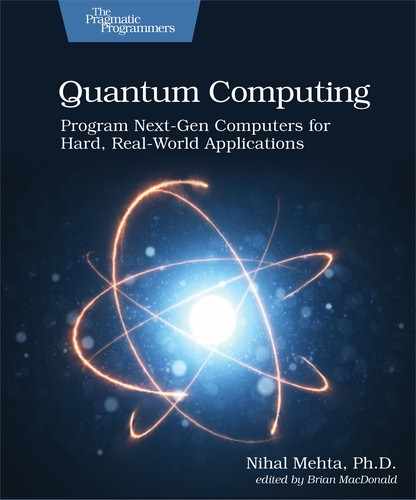[Quantum mechanics is] imaginary gardens with real toads in them.
Chapter
6
Designer Genes—Custom Quantum States
The core of quantum computing lies in the distinctive way that qubelets cancel out, leading to quantum states that rapidly collapse to the optimal solution or that entangle qubits so that they’re in lockstep. These phenomena have no analog in classical computing.
Entangled qubits, in particular, offer more ways to boost performance of hard-to-crack problems, such as earth-to-satellite communications. Here information is sent across noisy channels over large distances, and the challenge is to compress the signal to increase the rate of transmission with minimal loss of data. In these cases, we typically do the following:
-
Create two sets of entangled qubits.
-
Keep one set on earth and send the other group with the satellite when it’s launched into orbit.
-
Perform operations on the home qubits to put them into some state.
-
Transmit only the sequence of operations to the entangled qubits on the satellite.
-
The system on the satellite applies the sequence of operations on its set of entangled qubits and recovers the intended state of the qubits operated on earth.
The size of the message is highly compressed since you’re only sending the sequence of operations and not the final state of the home qubits. Moreover, the message is secure since any eavesdropper wouldn’t have the original entangled qubits to decipher the message.
For these types of quantum algorithms to work, we need a rich repertoire of gates that nudge qubits into quantum states with exactitude—merely splitting and inverting qubelets doesn’t give the fine-grained resolution demanded by these applications. So, our emphasis in this chapter is to build the scaffolding that bridges the visual qubelet model with the kinds of mathematics used in quantum computing. Once we understand how to meticulously fine-tune quantum states, we can then explore these applications in Chapter 9, Alice in Quantumland—Quantum Cryptography.
We start by covering how qubelets and quantum states are
denoted mathematically. Then we’ll expand our notion
of how the pentagon ![]() and
triangle
and
triangle ![]() qubelets give rise to
an infinite range of quantum states.
This generalized view of qubelets motivates
a new class of quantum states that precisely warp a
qubit into any quantum state we desire.
Instead of simply splitting qubelets symmetrically like the
H gate, we’ll learn to shape the quantum state
so that they heavily skew toward one or the other types of
qubelets. Unlike a fair coin toss, these
qubits strongly favor one classical state over the other.
qubelets give rise to
an infinite range of quantum states.
This generalized view of qubelets motivates
a new class of quantum states that precisely warp a
qubit into any quantum state we desire.
Instead of simply splitting qubelets symmetrically like the
H gate, we’ll learn to shape the quantum state
so that they heavily skew toward one or the other types of
qubelets. Unlike a fair coin toss, these
qubits strongly favor one classical state over the other.
Our main aim with quantum computers is to write programs for problems that resist solutions by traditional mathematical methods. It seems paradoxical, then, to undertake a mathematical study, especially since, due to their large sizes, we never explicitly program these techniques. So it’s natural to question what mathematics buys us.
Learning the mathematics behind quantum computing is important for several reasons:
-
It introduces us to the rich family of other types of quantum gates: these give us additional ways to manipulate qubits in applications such as quantum cryptography and superdense coding.
-
You’ll need the mathematics to analyze portions of your programs and motivate patterns for wiring quantum gates; in other words, the mathematical analysis will guide you in designing quantum algorithms for industrial-scale applications.
-
It gives a way to see what’s going on in our quantum circuits: unlike classical programs, you can’t put breakpoints in your code, expecting to probe intermediate quantum states—the qubits will immediately collapse.
Our interest, then, in the mathematics of quantum mechanics is strictly practical.
